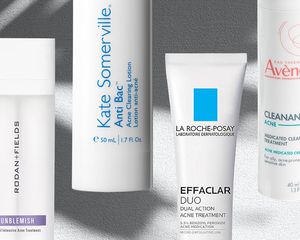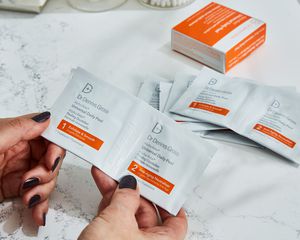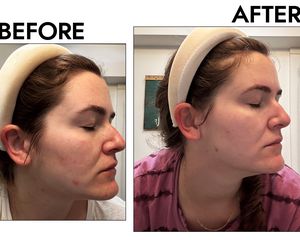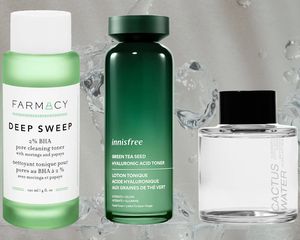:max_bytes(150000):strip_icc()/stocksy-4dc552c271d043d2a814a83872f5c2b4.jpg)
Stocksy
When it comes to acne-fighters, it's usually the heavy-hitting, more medicinal ingredients of the world that get all the attention. (You know, the salicylic acids and benzoyl peroxides of the world). But those aren't the only options. There's no denying that natural ingredients are having a major beauty moment, with more options out there than ever before that can do anything and everything, from hydrating to smoothing out wrinkles.
It's important to take all these claims with a grain of salt—check for scientific studies and proven findings—but there are a lot of great options. You can also add beating blemishes to that list, as it turns out that tea tree oil is a natural ingredient that has been scientifically proven to help treat all kinds of pimples.
Here, board-certified cosmetic dermatologist Y. Claire Chang, of UnionDerm; Chicago-based celebrity dermatologist Jordan Carqueville, and dermatologist Rachel Nazarian of Schweiger Dermatology Group in New York City weigh in on exactly what makes tea tree oil for acne
a great option, explain how it works, and share some of their favorite tea tree products. Get ready to say hello to a clearer complexion.
Tea Tree Oil
TYPE OF INGREDIENT: Essential oil
MAIN BENEFITS: Kills bacteria, fungus, and eases inflammation
WHO SHOULD USE IT: Those with acne-prone skin and fungal skin conditions, such as atopic dermatitis.
HOW OFTEN CAN YOU USE IT: According to Chang, tea tree oil should be applied twice daily for six to 12 weeks to start seeing a benefit. However, do not apply it directly to the skin—it should be diluted with a carrier oil, such as jojoba oil.
WORKS WELL WITH: Non-comedogenic carrier oils
DON'T USE WITH: Any other active product (benzoyl peroxide, salicylic acid, retinol, etc.).
What Is Tea Tree Oil?
"Tea tree oil is an essential oil derived mainly from a plant native to Australia known as Melaleuca alternifolia," says Chang. Like so many other natural and plant-based ingredients, it has a long history. It's been a traditional medicine used by native Aborigines for centuries, who purportedly inhaled tea tree oil to treat coughs and, you guessed it, applied it topically for skin healing. There are almost 100 components in the oil, one of the major ones being a compound known as Terpinen-4-ol. Without getting too complicated, the takeaway here is that this compound has all the good stuff, namely strong antimicrobial and anti-inflammatory effects, points out Chang. And it's those properties that are precisely what make tea tree oil such a good pick for acne-prone skin. (Not to mention that, unlike many other essential oils, it's non-comedogenic and won't clog pores, adds Nazarian). As if all of that weren't enough, tea tree oil offers some antioxidant properties, too.
The Benefits of Tea Tree Oil on Acne
- Kills bacteria: True acne is caused in part due to the presence of p.acnes bacteria on the skin. Tea tree oil has a broad spectrum of antimicrobial activity, notes Chang, including being effective against even staphylococcus aureus (AKA staph), and, yep, p.acnes, too. This was even scientifically proven in a study published in 2020 in the Saudi Journal of Biological Sciences. "Terpinene-4-ol is the active ingredient in the tea tree oil that destabilizes the cell of the bacteria, essentially killing it," explains Carqueville.
- Anti-inflammatory: At the same time, it decreases the inflammatory cascades that stimulate inflammation and redness, a major benefit for acne-plagued skin. The science is there to back all of this up as well; tea tree oil is an effective treatment for mild to moderate acne.
- It treats a wide range of acne: Here's the other nice thing: It can work on both comedonal acne (blackheads, whiteheads, smaller blemishes) and inflammatory acne (big, red, angry pimples). While the antibacterial and anti-inflammatory effects make it a slightly better option for the latter, "tea tree oil improves both comedonal and mild to moderate inflammatory acne, reducing the number of acne lesions as well as the severity of these lesions," says Carqueville. So much so, that it's even been compared head-to-head with another antibacterial acne-fighter, benzoyl peroxide. An older 1990 study published in the Medical Journal of Australia looked at the direct effects of a five percent concentration of tea tree oil versus five percent benzoyl peroxide. The results? Both treatments effectively addressed comedonal and inflammatory acne. Tea tree oil was a bit slower to work, but, it did win out when it came to having less irksome side effects associated with it, says Nazarian. Why you ask? "Tea tree oil is moisturizing, which differentiates it from topical benzoyl peroxide and retinoids, which are usually drying. In this comparative study, those patients using the tea tree oil had significantly fewer side effects of dryness and irritation," Carqueville explains.
Other Skin Benefits
- It's anti-viral and anti-fungal: Tea tree oil is not only effective against bacteria but also helps decrease fungus and viruses on the surface of the skin, adds Nazarian. This makes it a strong contender as a weapon against Athlete's Foot (fungal) and cold sores (viral).
- Reduces dandruff: "Given its anti-inflammatory and anti-fungal potential, it's been suggested for use in dealing with dandruff or seborrheic dermatitis," explains Chang.
- Heals minor cuts and scrapes: According to a 2006 study, tea tree oil helps kill MRSA, a type of bacteria that can cause infection in open wounds. It also increases white blood cell activity, helping to reduce healing time.
How to Use Tea Tree Oil to Treat Acne
"Tea tree oil can be found in multiple formulations, including toner, moisturizer, washes, and spot treatment, though it should be used twice daily for six to 12 weeks to start seeing a benefit," says Chang. You can pick up one of those products (keep reading for some of the derm's favorites), or you can use straight-up tea tree oil. In this case, you can either apply it directly onto blemishes with a cotton swab or mix a few drops in with a moisturizer to spread it onto wider areas, Carqueville suggests. You also don't have to use it on its own, but rather as an accompaniment to any other acne treatments you may already be using. "Tea tree oil can be used with other topical and oral acne medications for increased efficacy. Given the increased rate of antimicrobial resistance in p. acnes, there's been a push to use non-antibiotic products, like tea tree oil, as well as a combination of acne-fighting products together," says Chang. Carqueville agrees calling it, "a great, non-antibiotic approach to treating acne." Either way, once your skin does clear up, Nazarian suggests continuing to use it to both maintain results and prevent future breakouts.
It's also worth pointing out that tea tree oil shouldn't be reserved solely for your skincare routine; it can be beneficial for your scalp and hair, too. "Given its anti-inflammatory and anti-fungal potential, it's been suggested for use in dealing with dandruff or seborrheic dermatitis," explains Chang. You will also find it in some of the top shampoos for scalp acne.
Possible Side Effects
While tea tree oil is generally well-tolerated by most, Carqueville points out that it can trigger an allergic reaction for some. She suggests taking it for a test patch run if you're allergy-prone or have super sensitive skin, and discontinue use if any irritation, redness, swelling, or itching develops. Another good bet? Stick with diluted forms or products that are pre-formulated with a small amount if you're concerned about your skin reacting, advises Nazarian.
The Best Skincare Products with Tea Tree Oil
"This very lightweight option is great for those with oily skin, and you only need to use a few drops," says Nazarian of one of her picks. Also nice: The tea tree oil used in the formula is totally pure and sustainably sourced, made with hand-harvested leaves for a pure quality. If you are super oily, use it in lieu of a serum, otherwise, use it before.
"I reach for this after a long flight or during my time of the month to help prevent and reduce acne," says Chang. The refreshing sheet mask promises to both hydrate and contains tea tree leaf extract to calm down breakouts, as well as green tea meant to reduce inflammation. We give it bonus points for the wallet-friendly price tag.
Chang says this is one of her favorite tea tree oil-containing products on the market. "It can be used as a powerful anti-acne and anti-blemish cream, with an 81.5 percent concentration of tea tree leaf extract to calm down inflammation combined with salicylic acid to exfoliate the skin," she says. Rounding it all out is the addition of niacinamide, an antioxidant that pulls double duty to help soothe and decrease blemishes, she adds.
Acne-fighting tea tree oil is combined with brightening mandelic acid to both knock out current pimples and prevent the appearance of pesky dark marks being leftover. Nazarian also lauds it for being paraben- and fragrance-free (a bonus if you have sensitive skin), and for being highly concentrated so that you only need to use a small amount.
If you're looking for a pure version of tea tree oil, Carqueville suggests this guy. Made with only 100 percent organic tea tree oil, it's a great multitasker; dab it on to treat blemishes or use a little bit on your scalp to try to ward off dandruff and irritation. All those good-for-your-skin benefits make tea tree oil effective for scalp issues, too.
True to its name, this face wash promises to help balance your skin's pH and boasts a gentle, hydrating formula. Still, it's a good pick if you're pimple-prone: "Tea tree leaf oil soothes the skin and treats breakouts, and it also contains betaine salicylate to exfoliate and keep pores clear," explains Chang.
Constantly trying to find a happy medium for your combination skin? Chang recommends this oil. The tea tree oil is meant to ward off blemishes, but it also contains hydrating squalane (a lightweight and fast-absorbing oil that's very similar to the natural oil your skin produces). Use it solo, or mix a few drops in with your moisturizer for an added hydration boost, she suggests.



